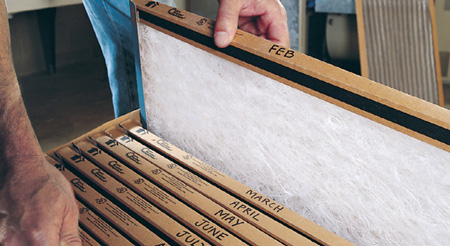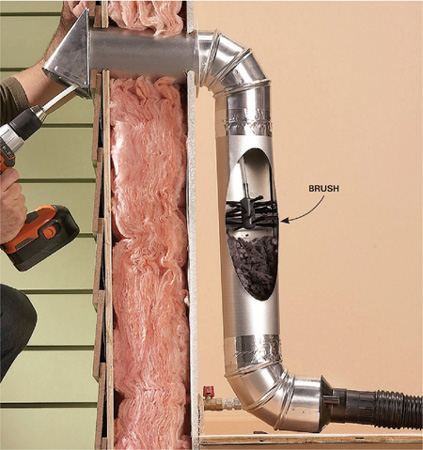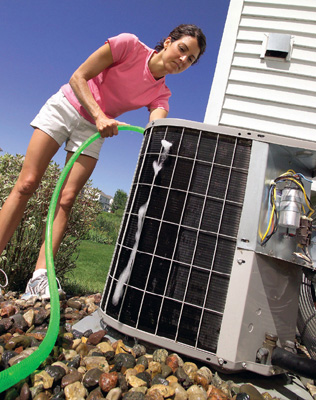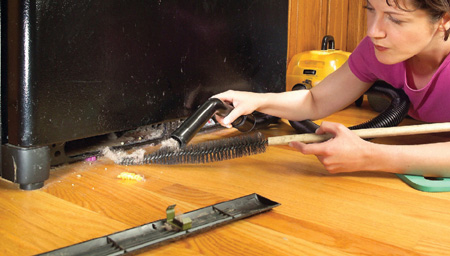
Keeping your furnace (gas or electric) tuned up has two big benefits: It makes the furnace run efficiently and it prolongs the furnace’s life span. And you can perform the annual tune-up yourself in about three hours (search for “furnace” at familyhandyman.com).
Change the filter every month of the heating season (or year-round if the filter is also used for A/C). Be sure you insert the new one so it faces the right way. The filter protects the blower and its motor; a clogged filter makes the motor work harder and use more power.

A clogged lint screen or dryer duct drastically reduces the efficiency of your dryer, whether it’s gas or electric. Clean the lint screen after each load and clean the exhaust duct once a year. The tool shown here has an auger brush that attaches to a drill to clean out the ducts. It’s available at home centers.
Electric dryers use about $85 of electricity annually. A dirty lint screen can cause the dryer to use up to 30 percent more electricity, according to the Consumer Energy Center. Lint buildup is also a common cause of fires.
Dry loads of laundry back-to-back so the dryer doesn’t cool down between loads (a warm dryer uses less energy). And only run the dryer until the clothes are dry. Overdrying damages your clothes and runs up your electric bill. If you’re in the market for a new dryer and already have a gas line in the house, go with a gas dryer. A gas dryer is more efficient.

Keep your dryer safe and efficient by cleaning lint out of the ductwork once a year.
Roughly half of an average home’s annual energy bill (gas and electric), about $1,000, is spent on heating and cooling. Air conditioners placed in direct sunlight use up to 10 percent more electricity. If yours sits in the sun, plant tall shrubs or shade trees nearby—but don’t enclose the unit or impede the airflow. Place window units on the north side of the house or install an awning over them.
Keep your window or central air conditioner tuned up so it runs at peak efficiency (search for “air conditioners” at familyhandyman.com to find out how to do it yourself). Every two or three years, call in a pro to check the electrical parts and the refrigerant (expect to pay $150 or more).
If your central air conditioner is more than 12 years old, replacing it with an Energy Star model can cut your cooling costs by 30 percent and save maintenance costs. The payback for replacing a 12-year-old system is typically about eight years. An air conditioner’s efficiency level is measured by the seasonal energy efficiency ratio (SEER). The higher the number, the more efficient the unit. A 13 or 14 SEER rating is considered high efficiency.

The best way to keep your air conditioner running at peak efficiency is to spend a couple of hours each year on basic maintenance—cleaning and straightening the fins, changing the filter and lubricating the motor.
Your refrigerator uses more electricity than all your other kitchen appliances combined. To keep its energy costs down, clean the coils twice a year, which improves efficiency by 30 to 50 percent.
Your fridge and freezer run more efficiently when they’re full. Put water containers in the fridge and ice bags in your freezer to keep them filled. Keep the refrigerator setting between 35 and 38 degrees and the freezer between 0 and 5 degrees F.
Refrigerator door seals wear out over time. Test your seal by closing a dollar bill in the door. If it pulls out easily, replace the seal (search for “refrigerator seal” at familyhandyman.com).
If your fridge was made before 2001, it’s using at least 40 percent more electricity than new Energy Star models. If you’re replacing your fridge, buy an Energy Star model and recycle your old one (visit energystar.gov and search “refrigerator recycling” to find out how). Don’t hook up the old one in the basement or garage—an inefficient refrigerator costs as much as $280 a year in electricity, according to the Consumer Energy Center. Any money you save buying food in bulk and storing it in an inefficient second fridge is lost in electric costs.

Brush and vacuum the coils at the bottom or the back of the refrigerator. A coil cleaning brush (sold at home centers) is bendable to fit in tight areas.